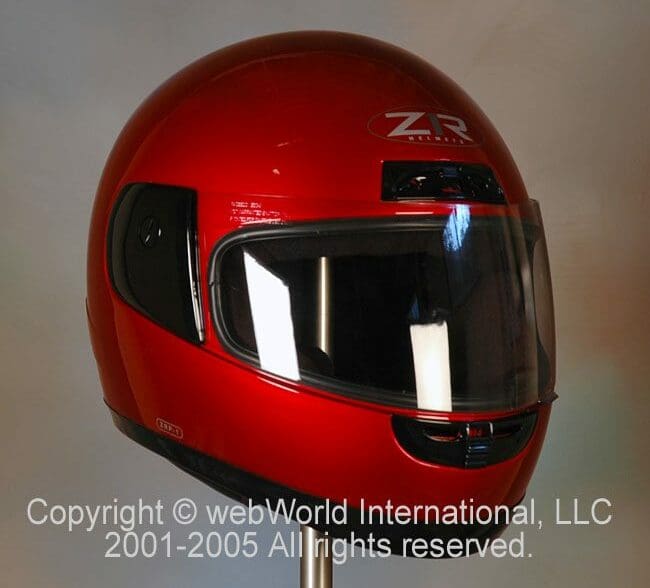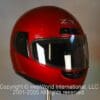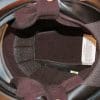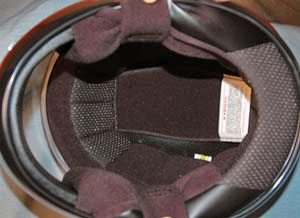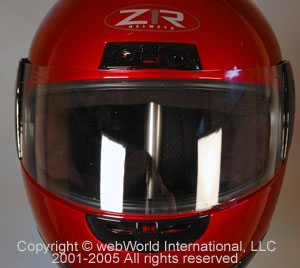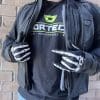The Z1R ZRP-1 helmet has a strange internal shape that may not fit all riders.
It also has an uncomfortable and rough-feeling liner.
Top if off with a very flimsy face shield and poor ventilation.
So it supposedly transmits lower G-forces in a crash…but if it’s not worth wearing, who cares?
One of the most famous of the Zen koans goes something like this:
“If a tree falls in the woods and no one is there to hear it, does it make a sound?”
A koan is a type of enigmatic riddle that is designed to prod a Zen Buddhist student to enlightenment.
A crude koan immediately came to mind as soon as I slipped the Z1R ZRP-1 (aka Z1R Strike) helmet over my head: “If a highly rated helmet is too flimsy or uncomfortable to wear, will anyone buy it?”
My first and emphatic answer was a resounding “no”.
But my knowledge of Buddhism tells me that the ego is one of the most common barriers to enlightenment, and mine is not of such stature that I can’t change my mind after further reflection.
Thus I warmed — albeit slightly — to the Z1R ZRP-1 after further consideration, as you shall see.
The Z1R ZRP-1 is also known as the “Z1R ZRP-1 Strike”, the “Z1R Strike” or by the name of its graphic versions, the “Strike Blade” or “Strike Razor”.
This is the helmet that has become surrounded by hype and controversy due to a recent series of articles in the Motorcyclist print magazine.
The magazine developed a series of tests to see how much energy or force is transmitted through motorcycle helmets to the headform, which was covered with electronic sensors.
The article is without doubt the most interesting to appear in any motorcycle magazine this year, and it has generated a huge amount of buzz with motorcycle riders, the motorcycle helmet safety standards community and the helmet manufacturers.
There are several reasons for this.
But the details can generally be summarized by saying that the helmet meets only the U.S. DOT approval, it lists for $79.95 in its most basic color (black or white), and it transmitted “only” an average of 152 G’s to the headform.
This is about half what the Snell standards call for, and part of the controversy extends to commentary made by Snell regarding the Motorcyclist tests.
We immediately wanted to take one through a detailed webBikeWorld evaluation for fit and comfort.
Knowing what we do about motorcycle helmets and buyer patterns after nearly 6 years of continual helmet evaluations, I knew that it wouldn’t matter how well the helmet tested with regards to the transmission of G forces.
If it was too uncomfortable to wear or if the fit and finish wasn’t up to snuff, it wouldn’t sell.
The Z1R Helmet
Z1R Helmets is a relatively small company, at least in terms of U.S. helmet sales.
The helmets are manufactured in China, and like several other Chinese motorcycle clothing and helmet products, it’s difficult to determine who designs the products, how they are made or even where the factory is located.
For all we know, the Z1R brand could be a made-up name that is used solely for the U.S. market.
This is common practice, not only in motorcycling but also in many other retail sectors.
Products that are similar in all but a few minor details, paint or graphics are frequently manufactured by a single company and then sold under several different brands, all looking like individual corporate entities.
Let’s just say that I would not be surprised if we found that a single helmet manufacturer in China or Korea or even Europe, for that matter, is using a single production line to manufacture dozens of different brands of motorcycle helmets, all veritable sisters under the shell.
As soon as the Motorcyclist article hit the newsstands, Z1R helmets became as rare as a set of Metzeler Tourance tires on a Hayabusa.
According to our industry sources, there weren’t many Z1R helmets on dealers’ shelves to begin with; there were very few in the monopolistic distribution system in the U.S.A., and the factory was caught completely by surprise.
Overseas lead times being what they are, the pipeline is still empty, some four months after the original article became public knowledge.
We’ve been trying to get a Z1R ZRP-1 since the article was first published, and we finally scored a metallic Cherry Red size XL after much effort.
Helmet Fit and Comfort
We really need to address the comfort issue first, because we think it may be a deal-breaker for many potential owners.
Our work at webBikeWorld allows us to evaluate many different helmets from around the world on a continuous basis. We probably wear more helmets in a year than many motorcyclists will see in their lifetime.
We know helmets and we have a “reference database”, if you will, of over 40 motorcycle helmets from around the world that we use to compare and contrast new arrivals for our review articles.
This is relevant because I will tell you that it is our opinion that the fit (the internal head shape) of our size XL Z1R ZRP-1 helmet is one of the strangest we’ve ever encountered.
Please visit the wBW Motorcycle Helmet FAQ page for a detailed explanation of motorcycle helmet fit vs. human head shapes and for tips on choosing a helmet. While you’re there, take a look at the “earth” shaped head graphic.
The Z1R ZRP-1 helmet is the classic definition of a helmet that fits this type of head shape.
This isn’t necessarily a bad thing; after all, there are very few helmets that will comfortably fit a round or earth shaped head, so if you’re an owner of said shape, you’re golden. If not, beware.
This is not a helmet that you’ll want to purchase sight unseen, because you may be in for a big disappointment.
I’ve worn a huge variety of helmets and I can tell as soon as I slip one over my head what I’m in for.
But I’ve also worn enough helmets to know that the liner, the foam and even the shell can stretch over time to make even an excruciatingly uncomfortable helmet, well, maybe not perfect, but at least bearable.
It’s been our conviction that helmet comfort is the most important factor after helmet safety for a motorcycle rider. If a helmet isn’t comfortable, it doesn’t matter how “safe” it is, the rider won’t wear it.
Pain and discomfort can be a danger when riding because they can distract the motorcyclist’s concentration and cause stress.
This can happen within minutes, especially at speed when the wind causes pressures on the helmet that could not be foreseen during a motorcycle shop try-on.
The Z1R ZRP-1, or at least our Cherry Red size XL example, has a very narrow head opening.
The bottom of the helmet must be stretched to the limit to get it over any of the size XL heads we’ve tried.
Once it’s on the rider’s head, the top of the helmet feels narrow, but the sides are so wide that I can place my hands alongside each of my ears and reach all the way to the back of my head.
Eyeglass wearers (or at least eyeglass wearers with earth-shaped heads) may rejoice at all the room around the middle of their heads.
The rest will feel like their head is the clapper in a school house bell.
The helmet is one of the most uncomfortable I’ve ever worn.
The combination of the narrow opening at the bottom and the wide sides leaves me feeling like I’m wearing a fishbowl.
The lack of support on the sides of my head also cause the helmet to move around on my head when I’m riding, which is disconcerting.
The Z1R ZRP-1 has a relatively uncomfortable liner, more so because the padding is thin and what padding is there is very firm and the material feels very scratchy, almost like it was made from rough wool.
Also, due to the internal shape of this helmet, the padding at the narrow bottom of the helmet near the neck presses into the soft flesh located in back of my jaws and under my ears, just below the temporomandibular joint .
This type of internal helmet shape immediately brings to mind a couple of potential problems:
How safe can the helmet be if the sides of the rider’s head are unsupported?
Another question that comes to mind is relative to the headform used in the Motorcyclist tests. What shape was it?
Does it take into account the differences in human head shapes that we and others have described?
Thus we come back to our koan: “If a highly rated helmet is too flimsy or uncomfortable to wear, will anyone buy it?”
Graphics and Colors
At a list price of $79.95, Z1R obviously didn’t have much flexibility to go wild. A Suomy Spec-1R Extreme it’s not, nor do we expect it to be so at about 1/8 the price.
Our Cherry Red metallic isn’t fancy, but it has a serviceable, albeit thin, finish. The Z1R ZRP-1 is so rare lately that we haven’t been able to evaluate any of the Blade or Razor graphics.
But at this price point, we’d just as soon buy the basic model and zoom it up with some reflective graphics or motorcycle stickers and decals.
Venting
Again, you won’t get much more than the basics at these prices.
The Z1R ZRP-1 has a basic brow vent that uses a lever to uncover two holes. The holes are drilled through the expanded foam helmet liner, and the air is not directed through any internal channels over the rider’s head.
Instead, the air blows rather uselessly on to the back of the thin fabric headliner.
In effect, the air flows into the holes in the brow vent and stop when it contacts the helmet liner. So don’t expect much, if any, air flow on top.
It’s a similar story for the chin vents.
A lever opens or closes a door that allows the air to stream up on to the back of the visor, and that’s it.
There are no holes in the back of the chin bar, although the chin bar does have a piece of material attached that give it a finished look.
There are exhaust vents on the back of the helmet in the lower rear section, but our determination is that these are for show only.
We can find no channel that might direct air from the front to the rear of the helmet and out these vents.
Fortunately, the helmet’s shape is such that a larger than normal amount of air seems to flow up from underneath during the ride, at least providing a minimal amount of ventilation.
But for those riding in warm to hot weather or living in warm climates, the Z1R ZRP-1’s ventilation is problematic.
Z1R Face Shield
Another problem here — the face shield on our helmet is very thin and flimsy.
If helmet manufacturers are going to use a thin, flexible face shield, then the lifting tab should be located low and in the middle. This might help prevent the extreme twisting that a thin face shield undergoes when lifted.
Our Z1R ZRP-1’s face shield literally feels like it’s going to pop off the helmet as it’s raised.
In addition, the detents are so weak that the face shield will not stay put in a couple of the middle positions on our helmet, even at rest.
The shield on our helmet also does not have a positive “click” or seal against the gasket when the visor is closed.
The best thing that can be said about the face shield on this helmet is that it uses a screw on either side to secure it to the rotating mechanism.
This helps keep it from coming off in the rider’s hands when it’s raised or lowered.
Noise Levels
Here’s the surprise: believe it or not, even with the large gap inside the helmet at the center, just around the rider’s ears and with a face shield that doesn’t seal correctly and with the unsophisticated shell shape, the ZRP-1 is a relatively quiet helmet.
It just goes to show that more money doesn’t necessarily buy low noise levels.
We’ve tried some very expensive helmets that are very noisy; designers have gone overboard with wings, vents and other tschotchkes on helmets lately, which usually undercut any work done in the wind tunnel.
Of course, since the ZRP-1’s air vents are virtually non-functional, and air vents can cause lots of noise, so it makes some sense that the helmet is quieter than others with large vent openings.
Some buffeting noise emanates from around the lower back section of the helmet, but it doesn’t seem to change whether the rider is behind a half-faring or not.
This is another surprise, and it again just shows that there’s lots of black magic involved in helmet design relative to noise control that isn’t necessarily related to the helmet’s cost.
See the wBW Motorcycle Helmet Noise page for more information on helmet noise and for some MP3 files that are recordings of the sound experienced with different helmets for comparison.
Weight
The ZRP-1 weighs in at 1572 grams, or 3 pounds, 7-1/2 ounces. This is very light, and is almost identical to the much more expensive Suomy Extreme Spec-1R.
Unfortunately, because of the shape and fit, the ZRP-1 doesn’t feel as light weight as it could.
Conclusion
After all this, you’re probably thinking we’ll tank the ZRP-1, no? Not necessarily.
We’ll admit that it falls below our standards for a helmet that we could live with, day in and day out. Its internal shape is too uncomfortable for many riders.
We have some questions about the internal helmet shape and how it might affect the transmission of energy for those whose head shapes don’t match. The liner is thin, stiff and the material feels scratchy.
The face shield borders on unacceptable and the venting is nearly non-existent.
However, the more I wore the helmet over the past few weeks, the more I came to accept its foibles and come to grips with its shortcomings.
I’m not sure why this is, although either the liner has softened up a bit over time or my head is becoming used to it.
The helmet has somewhat of a novelty status right now because of the Motorcyclist article.
Our feeling is that we would not run out and buy one solely because of the article; we think there’s lots more of the story to tell regarding overall motorcycle helmet safety before the final verdict is in.
Let’s face it — there are many motorcycle helmet manufacturers and helmet standards organizations who have been studying this issue for many years.
We’d sure like to hear what they all have to say before we decide that a $79.95 helmet is the only way to go. And the Motorcyclist article, if you recall, did not address the comfort factors of this helmet at all.
This is in no way, shape or form meant to disrespect Motorcyclist magazine. We think they have done an outstanding job on this and many other topics.
We think that it’s absolutely fantastic that they are right out in front of the extremely important issue of bringing helmet testing standards into the 21st Century.
We hope they continue their work, and we urge every one of our visitors to read the Motorcyclist articles on this topic. Heck, you may even want to get a subscription!
But we’d also bet that the Motorcyclist staff would agree that it’s important to consider all of the many different factors that surround the choice of something as personal as a motorcycle helmet.
We have always maintained that comfort is one of the most important.
The bottom line? All things considered, including the price/value equation, I feel better wearing my Arai Quantum II and will continue to do so for the near future.
Owner Comments and Feedback
See details on submitting comments.
From “TKF” (5/09): “Thanks for your review of the Strike Blade. I own a “large” size ZR-1 that I bought not too long after the Motorcyclist article came out.
It is the exact helmet pictured in the article, yellow and black. I ride a yellow and black 2001 CBR929.
I am a little surprised you had so much trouble getting one.
I was, coincidentally, in need of a new helmet when that article was published. I was unsure what helmet to purchase because of all the choices available, and the huge price differentials.
The two helmets I owned before my ZR-1 were, most recently, a Shoei, and before that an Arai.
I ordered it online and received it with no undue wait. Sorry, I cannot recall which retailer. I also did find a Pep-Boys brand locally, but not in a color or design I wanted.
I have had my ZR-1 for about 3 years now, (I lose track of time, let’s say I got it about 1-2 months after the article came out) and so because I have had it for some time, a lot of that “adjustment” which happens over time, be it real and/or psychological, has happened.
I do, however, remember my impression trying it on for the first time, and I absolutely recall a “floating” feeling on the sides of my head, like the helmet has some extra room.
My old Arai fit very snugly against my cheeks, and I liked the Shoei better because it gave me a bit more room inside (I am a bona fide large, always, in hat and helmet sizes). But the ZR-1 did indeed feel different, not nearly as snug as other motorcycle helmets I have worn.
So now, after riding with the helmet for some years, the main disadvantage I would caution potential buyers about is, it’s COLD!
If you ride in winter weather, don’t expect too much in terms of wind protection.
I mean, yeah, it’s a whole helluva lot better than going bare skull, but the wind gets inside this puppy pretty good, and although that’s a good thing for clearing the fog on the face shield, it’s not a welcome thing in many other ways.
I actually got a balaclava (head liner you wear separately) after my first winter with it. If I had to take long cold weather trips regularly (I don’t) I certainly would be shopping for something else.
I have a full head of thick hair, I wear ear plugs during any extended highway trips – but this helmet lets a lot of air in underneath, as you have described. The balaclava is a pain, only for long trips, but I always use a scarf.
Other than that, I find the face shield and the system that ratchets it “adequate” but far from the high-tech designs of Arai and Shoei.
But fair is fair: the Shoei used to lose a pivot screw at least once a year from the hinges, even though I would do my best to stay on top of tightening them with any dime I had handy.
The ZR-1 has not left its remains on the highway as yet.
Sum it up? I like the ZR-1. It’s a great warm weather helmet, and I am used to its somewhat unusual inner dimensions. It feels normal to me now. But wear a scarf!”
From “M” (9/08): “I have the Z1R Strike. Got it before the articles came out. Don’t understand the “most uncomfortable” comment and the “very thin and flimsy visor” comment. I have over 50,000 miles with this helmet.
Had one 22 hour day lately and never felt that the helmet is uncomfortable. I’m only on my second visor so I guess flimsy is not a problem either. Visor will stay up at speed if I choose to ride that way.”
From “M.P.”: “I’m surprised you didn’t pick up on the helmet being a complete copy of the HJC CL-11. I don’t have docs to prove it but I do believe it’s an officially licensed design.
I’ve owned a CL-11 and not 2 weeks after tossing it I got my Z1R and low and behold everything is exactly the same.
Except perhaps sound and build quality which is superior to the CL-11. Granted maybe the foam liner is different since the CL-11 was SNELL certified and the Z1R isn’t.
I am VERY happy with the Z1R (size S) and recommend it to anyone. It fits me perfectly just like my Shoei RF800 did.”
Editor’s Note: I don’t know if the (Z1R) is made by HJC or a duplicate or…. But I wouldn’t be surprised.
I think there are far fewer helmet manufacturers than there are companies that sell helmets, and many of them are brands created solely for the purpose of marketing helmets.
I’ve never tried a CL-11, so I have known that the two may be similar. Glad you like the helmet.
From “D.” to clarify the origin of Z1R helmets (see note from “N.” below): “I asked Z1R about the “N” person’s comments (below). Here is the reply I received (from Tom Kingsland, Z1R Brand Manager):
“Z1R helmets are a brand owned by LeMans Corporation, owner of Parts Unlimited and Drag Specialties.
Z1R Helmets my not be in every dealership but are available through Parts Unlimited dealers and stock has been good.
The Z1R Helmets are developed by Z1R and manufactured by Hong Jin (Beijing) Sports Goods Co. and J-tech in Korea and China.
Lots of helmets appear to be the same but things are not always the way they look on the outside.
The Strike is not the same helmet as the Pep Boys Model.
The head form is based on the North American head form; which is oval in shape, versus a round shape.
Hope this help clarify some things. Feel free to contact me with any other questions (at) 608-758-1111. Tom Kingsland, Z1R Brand Manager”
Thanks for the great reviews! Keep them coming on all the latest stuff. I won’t buy anything without reading reviews!”
Editor’s Note: Thanks for sending this information “D.”, hopefully it will clear up some of the mystery.
Not sure I agree with the “stock has been good” part. We tried every Z1R dealer we could find numerous times between June and October before we were finally able to find a single ZRP-1 helmet in stock.
From “N.”: Hi, I just read the review of the Z1R helmet on your site. Thought maybe I could add some clarity on some issues or questions you had about it.
From what I gather, Z1R appears to be a brand name created by Parts Unlimited. All of their helmets appear to be rebranded, currently available Asian models of one sort or another.
Similar with their other marketing brand, Icon.
The Strike appears to be the same helmet as the Pep Boys-sold Raider helmets, which were also part of that Motorcyclist comparison article, made by Queen Kwan Enterprise Co Ltd, or Arc Helmets.
That also certainly begs the question about the difference in the impact test number values in that article.
There are a number of Chinese and Korean manufacturers that are either wholesaling their products to other major names, manufacturing older designs, or successfully copying big-name products.
The ARC flip-up certainly resembles the HJC Symax or CLMax as well.
The Z1R Stance as well as both Icon offerings appear to be made by J-tech Corp in Korea, known as Xpeed Helmets.
The Stance is identical to the Xpeed 503, and the Alliance appears to be a slight variation, of the same helmet, and the Mainframe and new Alliance SS look to be variations on the Xpeed 705 or the 503 again, just in fiberglass.
Just throw on some fancier vent covers and paint designs. The Snell website lists the Alliance and Mainframe under both Icon and J-tech in their list of certified helmets as well.
In regard to the fit, DOT requirements use the old cubic headform, whereas Snell and BSI use the ISO headform that more closely resembles the human head.
This could be a very good reason for the difference in feel, and quite possibly have something to do with passing those standards, I suppose, especially with the roll-off retention requirements that are not included in the DOT standard.
Though it sounds like you had a hard time getting this particular helmet on and off.
It looks like ARC is strictly making DOT-only helmets, but most of these wholesale manufacturers make them to any and all of the various standards available, and are “ISO-certified”. Thanks again for another great review.”


